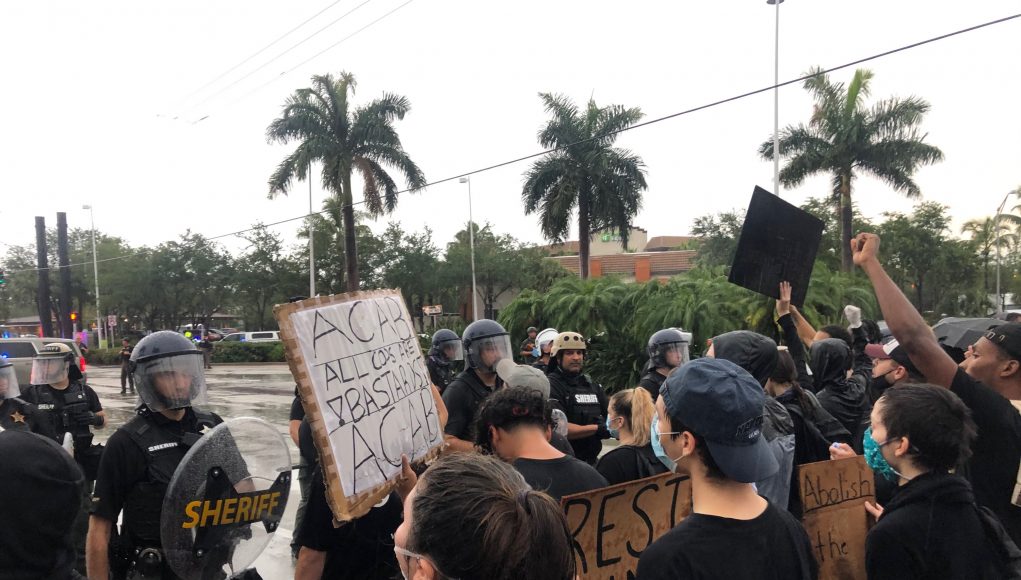Amid the continuous protests against racial injustice that erupted this summer across the nation, one action was demanded by protesters everywhere– defund the police. Activists in Southwest Florida have lugged the debate to Collier County and are asking the Board of County Commission to act on recent events.
Commissioner for District Five William McDaniel Jr. said that’s not going to happen. He said defunding the police is completely out of the question, and the rest of the county committee agrees.
“We have no interest in defunding our sheriff,” said McDaniel Jr., who oversees Golden Gate, Golden Gate Estates and Immokalee, home to many of Collier County’s Black and Brown populations. “…We need to re-instruct our law enforcement officers… They need to be better trained to recognize mental illness and substance abuse and better training on how to diffuse those circumstances so negative circumstances don’t transpire.”
Collier County spent over $200 million for the fiscal year of 2019-2020 on its police force, accounting for over 40% of its budget. The county also reports among the lowest crime rates in the state, and the lowest for a metropolitan county, according to the Florida Department of Law Enforcement.
Over the past few years, the Collier County Sheriff Office’s budget has increased exponentially by over $65 million from 2014 to 2019. The county’s current budget for 2021 allocates $203 million, with a proposal for a $3 million expansion in personal services, to the sheriff’s department.
Images of tear gas-stricken protestors and officers clad in military-grade uniforms have become almost the norm in the United States, forcing many citizens to come to terms with the current state of policing.
The order to defund comes off as ludicrous to many, with seemingly contrasting approaches. Some are calling for a complete end to the police, while others suggest reform or slight alterations. At the center of the call, supporters are calling for cuts to city and county police department budgets and reallocating funds to more community-based initiatives. Some city councils have fallen in line with the phrase and have made efforts to cut and shift funding.
Minneapolis, the city where 46-year-old George Floyd was killed by Minneapolis Police Officer Derek Chauvin, igniting nationwide protests, proposed to cut $600,000 of the city’s police department budget of $193 million. The city council announced a charter proposal to eliminate the need for a police department — but a committee delayed that proposal.
“When you think about defunding, it’s not about ‘okay, we’re just going to cut your budget by 50%’. No, it’s about changing the system and shifting public monies but making it so we don’t need so many police,” said Tim Goddard, associate professor in the Department of Criminology and Criminal Justice at Florida International University.
What does defunding the police mean?
The call made by activists is to gradually disassemble or reduce the police force by reallocating funds to more community-based or social programs and services. Police forces around the country are funded by hundreds of millions — sometimes billions — of taxpayer dollars, accounting for the majority of some budgets. Social and community-related programs cost significantly less money and are oftentimes cut in adopted budget hearings.
The United States annually spends about $100 billion in policing, and another $80 million on incarceration, as noted by Forbes. Police budgets for major metropolitan areas continue to consume from 20 to 45 percent of major metropolitan area budgets.
One of the main arguments from all sides of the debate is who should citizens call for non-criminal issues. Police officers undergo around four to six months of training to become a cop, but oftentimes are not trained to handle individuals with mental illness or substance-abuse issues. Cities and counties have employed some programs to alleviate some of the duties of police officers and put it in the hands of other community or social workers.
For instance: Eugene, Oregon implemented CAHOOTS, also known as Crisis Assistance Helping Out On The Streets, a 24/7 mobile crisis intervention team that is transmitted through a non-emergency number. The team addresses non-criminal cases, ranging from substance abuse to mental illness issues to dispute resolution, with the help of a medic and highly experienced crisis worker. When called, workers on the team assess the situation, provide stabilization of urgent medical or psychological needs, offer other important referral or advocacy information and if needed, transportation to a specific treatment.
The initiative is funded by the Eugene city government, which in the fiscal year of 2017-2018 allocated $798,000 to the program. Last year alone, CAHOOTS only needed police backup for 150 out of the approximately 24,000 calls made. In 2017, the action group responded to 17% of the calls from the Eugene Police Department, according to the White Bird Clinic website. Other cities have implemented a CAHOOTS, or a similar program within their police departments.
Government funding of such initiatives can be tricky, says Goddard. If such a group chooses to operate mainly on government funds, then they are subject to being controlled by officials, who can at any time cut funding or operations altogether.
“There’s a dilemma when it comes to say, you know, organizations, about where they receive funding,” said Goddard. “It’s not to say that public funding shouldn’t be shifted to it, but one has to be very careful on how dependent one would want to be organizationally on public funding.”
What are activists asking for?
Collier County activists have concocted a list of demands for funding. These have strongly highlighted mental health and the community and services division of the budget, which include items such as affordable housing and senior services, which account for less than 5% of the overall budget.
“We have a lack of housing, we have a lack of mental health resources,” said Tharina Oris, a member of the group Collier Youth for Black Lives. “I see no reason as to why the $200 million should be gathered there when other people are suffering.”
Among the aforementioned areas activists want a portion of CCSO funds to go to, demonstrators also want the sheriff’s office to end the 287(g) agreement. The program allows the sheriff’s department to voluntarily turn county residents over to Immigration and Custom Enforcement to be detained and deported.
Police department cuts by Tamica Jean-Charles
Maureen Porras, a democratic candidate for the District 105 seat in Florida, says citizen efforts need to be targeted at both the state and local level in order to change the current state of policing. She says she’s seen immense efforts from citizens and officials of Broward and Miami-Dade County, which are also in District 105, but has seen less responses from Collier County.
Starting from changing statutes to end mass incarceration and promoting rehabilitative services, to pushing to end police contracts that make it difficult to investigate and axe the “bad” cops — to see such change in Collier County will be extremely difficult.
“I think we all know that the system needs to be reformed,” said Porras. “It’s just, elected officials are just not doing it. And unfortunately, Collier County officials are not doing it.”
What’s happening now?
Since June 1, activists have periodically protested outside the courthouse building at the Government Center pushing for more focus and funding on social services. CY4BL, a new social justice organization based in Collier County, recently held a protest in light of this issue, but was dismissed by the commission after the first public comment.
CCSO currently has a Crisis Intervention Team, or a 40-hour class that deputies take to better understand and de-escalate situations through simulations. So far, the program has trained over 2,000 people, and according to the National Alliance on Mental Health Collier County, the entire Naples Police Department. Yet, the program is not required for CCSO officers.
“While the goal is for 100% of deputies to be trained in CIT, there are always new deputies joining our agency who have not yet been through it,” said Karie Partington, spokesperson for the CCSO.
Ellen Hemrick, a member of Showing Up For Racial Justice, says the team is a “nonsensical” way of addressing individuals with mental health. Money is invested into the 40-hour class, that is open to all positions within law, rather than aiding the David Lawrence Center that only has 30 community health beds to account for over 350,000 residents.
“I strongly believe people who become police officers did not sign up to become mental health crisis workers,” said Hemrick. “And therefore, I think it’s a real mismatch in both their level of training and their intent for interacting with the community.”
McDaniel Jr. says the county has drafted a new plan and is allocating “large amounts of ad valorem dollars” back into rehabilitative institutions and efforts. He says he has ideas to bring on community-based programs or initiatives, but has yet to announce any active plans.
“We’re putting our tax money where our mouth is with regards to the necessities of providing for these adjustments,” said McDaniel Jr.
In the meantime, Hemrick says SURJ has already started a letter-writing campaign for members and citizens to submit their concerns with the commission, and is working on another campaign to address where candidates for FL-District 19 stand on racial justice issues.
“We’re in this for the long haul,” says Hemrick.
































